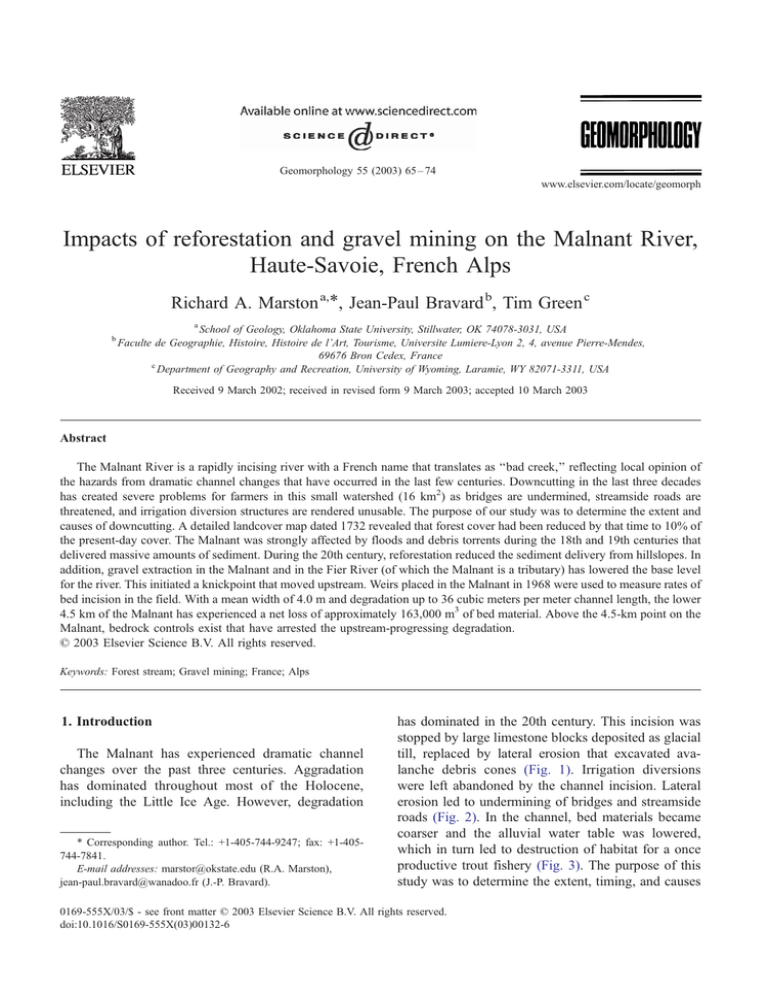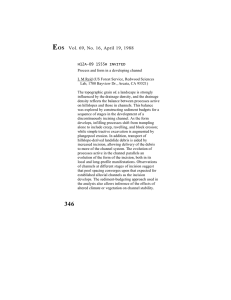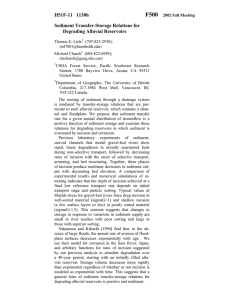Impacts of reforestation and gravel mining on the Malnant River,
advertisement

Geomorphology 55 (2003) 65 – 74 www.elsevier.com/locate/geomorph Impacts of reforestation and gravel mining on the Malnant River, Haute-Savoie, French Alps Richard A. Marston a,*, Jean-Paul Bravard b, Tim Green c b a School of Geology, Oklahoma State University, Stillwater, OK 74078-3031, USA Faculte de Geographie, Histoire, Histoire de l’Art, Tourisme, Universite Lumiere-Lyon 2, 4, avenue Pierre-Mendes, 69676 Bron Cedex, France c Department of Geography and Recreation, University of Wyoming, Laramie, WY 82071-3311, USA Received 9 March 2002; received in revised form 9 March 2003; accepted 10 March 2003 Abstract The Malnant River is a rapidly incising river with a French name that translates as ‘‘bad creek,’’ reflecting local opinion of the hazards from dramatic channel changes that have occurred in the last few centuries. Downcutting in the last three decades has created severe problems for farmers in this small watershed (16 km2) as bridges are undermined, streamside roads are threatened, and irrigation diversion structures are rendered unusable. The purpose of our study was to determine the extent and causes of downcutting. A detailed landcover map dated 1732 revealed that forest cover had been reduced by that time to 10% of the present-day cover. The Malnant was strongly affected by floods and debris torrents during the 18th and 19th centuries that delivered massive amounts of sediment. During the 20th century, reforestation reduced the sediment delivery from hillslopes. In addition, gravel extraction in the Malnant and in the Fier River (of which the Malnant is a tributary) has lowered the base level for the river. This initiated a knickpoint that moved upstream. Weirs placed in the Malnant in 1968 were used to measure rates of bed incision in the field. With a mean width of 4.0 m and degradation up to 36 cubic meters per meter channel length, the lower 4.5 km of the Malnant has experienced a net loss of approximately 163,000 m3 of bed material. Above the 4.5-km point on the Malnant, bedrock controls exist that have arrested the upstream-progressing degradation. D 2003 Elsevier Science B.V. All rights reserved. Keywords: Forest stream; Gravel mining; France; Alps 1. Introduction The Malnant has experienced dramatic channel changes over the past three centuries. Aggradation has dominated throughout most of the Holocene, including the Little Ice Age. However, degradation * Corresponding author. Tel.: +1-405-744-9247; fax: +1-405744-7841. E-mail addresses: marstor@okstate.edu (R.A. Marston), jean-paul.bravard@wanadoo.fr (J.-P. Bravard). has dominated in the 20th century. This incision was stopped by large limestone blocks deposited as glacial till, replaced by lateral erosion that excavated avalanche debris cones (Fig. 1). Irrigation diversions were left abandoned by the channel incision. Lateral erosion led to undermining of bridges and streamside roads (Fig. 2). In the channel, bed materials became coarser and the alluvial water table was lowered, which in turn led to destruction of habitat for a once productive trout fishery (Fig. 3). The purpose of this study was to determine the extent, timing, and causes 0169-555X/03/$ - see front matter D 2003 Elsevier Science B.V. All rights reserved. doi:10.1016/S0169-555X(03)00132-6 66 R.A. Marston et al. / Geomorphology 55 (2003) 65–74 Fig. 1. Incision in upper Malnant, halted by large blocks in bed material that exceed competence of stream. For scale, note person near lower right in channel. of channel degradation. The study has broader implications for how changes in hillslope land use and geomorphic processes can reverse centuries-long channel regimes from aggradation to degradation in mountain watersheds. 2. Physical setting of the Fier and Malnant The Malnant drainage covers 15.9 km2 within the upper Fier watershed in the Bornes Range within the Haute Savoie of the French Alps (Fig. 4). The drainage is an anticlinal valley underlain by Oligocene limestone and sandstone that have been folded and faulted by alpine tectonics (Figs. 5 and 6). The watershed was glaciated during the Pleistocene and the Little Ice Age. Valley glaciers deepened the fluvial valleys, deposited till, and truncated large alluvial fans (BRGM, 1990). The Malnant is a 7.1-km-long tributary that drops from a headwater elevation of 1835 to 600 m where it joins the Fier River, made famous as a favorite flyfishing stream of Winston Churchill. The Malnant contributes very little flow to the Fier but does contribute the majority of bed load. Elevations in the Malnant range from 450 m in the valley to over 2000 m on the drainage divide. The watershed receives an average annual precipitation of 1500 mm, including heavy winter snows on the steep valley sidewalls that frequently trigger avalanches. Precipitation is derived from oceanic rains and by the orographic influence of the Aravis Ridge. The highest monthly precipitation is f 190 mm in December, and the lowest monthly precipitation is 120 mm in April. Snow contributes in water retention with a thickness of 1.80 m at Thônes and 4.80 m in the Aravis Ridge (Cholley, 1925). The Malnant valley was excavated by glaciers during the Quaternary and has been sculpted by slope processes since the Late Pleistocene, including mass movement from the western hogback below Couturier Ridge, avalanches from the hogbacks surrounding the valley, rockfalls from the southern end of the valley, and debris torrents in ravines originating above 1500 m. 3. Geomorphic response to land use 3.1. Mid-14th century to end of 19th century Heavy flooding and snow avalanches from the mid-14th century to the end of the 19th century created sizeable debris cones at the foot of valley sidewalls. Large woody debris has been recovered from debris cones that yielded carbon dates of R.A. Marston et al. / Geomorphology 55 (2003) 65–74 67 Fig. 2. Undermining of roads (top) and bridges (bottom) by Malnant. 135 F 45 years. Severe floods were recorded in 1854, 1859, 1875, 1879, and 1899, all of which devastated the hamlet of Montremont (Mougin, 1914). This hillslope instability may be attributed to deforestation that provided wood as the primary fuel for residents of Montremont and was utilized by a local glass factory in the village of Allex, active from 1755 to 1860. Deforestation of the original forest of white fir (Abies alba) and beech (Fagus silvatica) was widespread from the 16th century through the early 18th century. Forests were converted to pastures for summer grazing at elevations above 1500 m, to meadows for summer grazing between 1500 and 1000 m, and to ploughed fields for cereal grains on the valley floor below 1000 m. A detailed land cover map dated 1732, the so-called Sarde Map of Thônes Parish, was 68 R.A. Marston et al. / Geomorphology 55 (2003) 65–74 and that the Little Ice Age (mid-14th to the end of the 19th centuries) was the most active period. This was probably due to extensive forest degradation performed since the Middle Ages, which was a period of dense human occupation at high altitude in a phase of climate warming until mid-14th century (Ladurie, 1983). Rivers of the Alps experienced a metamorphosis from meandering to braiding in response to an increase of bed load, and this metamorphosis extended downstream from the inner Alps to the piedmont areas surrounding the Alps (Bravard, 1989). However, the 19th century was not homogeneous since the existence of several low-flow-dominated and flood-dominated periods alternated during that century. This periodicity has been demonstrated in the Pre-alps of Die, south of the study area. The years 1800 – 1820, 1840 – 1842, 1850 – 1851, and 1856 – 1875 were particularly severe; and the exceptional flood of 1856 motivated the French Parliament to enact the 1860’s law on montane reforestation (Bravard, 2000). 3.2. Twentieth century Fig. 3. Coarsening of bed material with progressive channel incision in upper Malnant and concordant loss of aquatic habitat. studied by Moutard (1995). This map revealed that forest cover had been reduced to 10% of the presentday cover. Mougin’s descriptions date back to a period when foresters attributed the supposed increased activity of alpine torrents during the 19th century to human action. The French Revolution (1789 – 1799) was supposed to have increased individualism and to have permitted an intense degradation of forests (Surell, 1841). This view was contested in the 1920s by renowned geographers such as Lenoble (1923), who argued that forest degradation had occurred in earlier centuries. This view tended to reduce blame that had been placed on the upland peasantry. More recent works have demonstrated that the Alps have experienced several phases of increased torrential activity during the Holocene In response to the hillslope instability and associated problems for valley residents, the French governments purchased the upper 15% of the watershed between the years of 1883 and 1903 and began a program of reforestation and avalanche mitigation (Fig. 5). On the upper slopes, structural walls were installed and the slopes were terraced to retain snow. On the lower hillslopes, landowners constructed stonewalls and rock-filled wooden boxes to retain avalanches before they could advance onto the valley floor. Beginning in the 20th century, sediment supply from hillslopes to the upper Malnant was reduced. Without this sediment input, the Malnant began to incise and bed load was mobilized. In our channel survey of the upper Malnant, the rotor from a British plane that had crashed in the 1950s near the headwaters was found incorporated into the bed load approximately 2 km downstream from the crash site. Downcutting in the last three decades has created severe problems for farmers in this small watershed as bridges are undermined, streamside roads are threatened, and irrigation diversion structures are rendered unusable. Indeed, Malnant trans- R.A. Marston et al. / Geomorphology 55 (2003) 65–74 69 Fig. 4. Geologic setting of the upper Fier watershed. The Malnant enters the upper Fier from the south just downstream of Thones. lates from French as ‘‘bad creek,’’ ‘‘. . .a native expression reflecting a secular wisdom’’ (Cholley, 1925). 4. Field surveys of channel incision 4.1. The upper Malnant: above 820 m elevation The steep upper Malnant begins at the convergence of a series of ravines and avalanche paths that collect water, snow, and sediment from the upper limestone cliffs. The bed of the upper Malnant is characterized by steep, rocky outcrops upstream of 1100 m, by boulder and log steps between 1100 and 950 m, and is incised into till deposits between 950 and 850 m. In the section between 1100 and 950 m, we computed that 18 out of 140 m (13%) of the drop in relief was controlled by log steps. The large woody debris originates from avalanche paths, and this may reflect the increase in supplies of large woody debris following the success of afforestation programs. At an altitude of f 950 m on the left bank of the upper Malnant, we found a piece of wood preserved below a large block belonging to a layer of coarse deposits. This alluvial layer was covered by large fir trees and riverine willows dating back to a period when the torrent was not yet incised. Radiocarbon dating provided the date of 135 F 45 BP. This date is consistent with the period of increased torrential activity described earlier. Floods of the 20th century have triggered incision of the bed of the upper Malnant, and this incision has exhumed large blocks. Recent activity of ravines, still active on the partly protected slopes, has delivered a large amount of small debris (plates of Hauterivian marly limestones) that covered the coarse deposits with a 4-m-thick layer. This debris replenishes bed materials that had been lost by incision. Floods in the Malnant export a portion of this material and move it downstream. This fine debris was excavated in the 1970s by a contractor at the downstream limit of the State Forest (1020 m). This instream mining interrupted the downstream transport and created a knickpoint, which migrated upstream until blocked by large boulders. This excavation stopped 20 years ago, but new deposition since that time has been rather low. 70 R.A. Marston et al. / Geomorphology 55 (2003) 65–74 Fig. 5. Geomorphic map of the Malnant drainage, highlighting avalanche paths, mass movement, areas of afforestation, and the alluvial fan that has developed where the Malnant joins the upper Fier River. Transect A – AVis shown as a geologic cross-section in Fig. 6. 4.2. The lower Malnant The 4-km-long reach between 820 m and the confluence with the Fier River is comprised of gravel, cobbles, and boulders deposited during the high energy floods of the Little Ice Age. The fining of coarse sediment is linked to the reduction in bed slope, but steep tributaries delivered coarse debris until the downstream end of the reach. Downstream of Bélossier Bridge (km 6.500), the Malnant River has built a large alluvial fan since the Late Glacial. This fan has been incised during the Holocene (undated phase), and a new fan has been emplaced during the Little Ice Age. The material of this late phase of the fan is coarse (gravel and small boulders) if compared to the underlying material, which is composed of small debris. Also, it is partly composed of urgonian boulders originating from the upper cliffs of the watershed, while small debris of the lower layer originate from Hauterivian marly limestones with few urgonian elements. Incision through coarse material was exacerbated when the upper layer was R.A. Marston et al. / Geomorphology 55 (2003) 65–74 71 Fig. 6. Geologic cross-section of the Malnant along A – AVtransect in Fig. 5. removed and when the fine debris were reached following bed degradation in the 1960s. This reach has been recently degrading because of the upstream reduction in sediment delivery and because of gravel extraction upstream. This process promoted a downstream progradation of erosion. Also gravel extraction downstream along the Fier River promoted regressive erosion to the detriment of the Malnant River bed. Moreover, the tributaries of the downstream reach of the Malnant have been efficiently controlled by the French government and are almost no longer active. Degradation was measured on the Malnant from an altitude of 820 m (km 2.500) to the confluence of the Fier River (km 7.100 m, 595 Fig. 7. Rock spur (see arrow) suspended above the alluvial fan at mouth of Malnant, representing 7 m of incision since 1968. 72 R.A. Marston et al. / Geomorphology 55 (2003) 65–74 m). Degradation could be dated considering that deflection devices made of concrete were installed at 41 points along the lower 4.5 km of the Malnant in 1968 by the Agricultural Service of the Department of Savoy in order to trap sediment and to control strong lateral erosion (Fig. 7). The spurs were seated into one bank and have not been successful in stopping incision. Indeed, the rock spurs provided time markers against which post-1968 incision could be measured. We measured the change in elevation below the rock spurs and the width of the stream at each point. By considering the channel length between the rock spurs, it was possible to calculate the volume of bed material that had been excavated (Fig. 8). Over 163,000 m3 have been exported from the lower 4.5 km of the Malnant. This converts to a mean of 36 m3/ m length of channel. Channel width varies from 4 to 18 m. Aside from the reduction in sediment supply from hillslopes to the Malnant, two other processes have contributed to incision. First, sediment has been mined at six points along the channel. Second, and most important, the base level of the Malnant was lowered and the channel has adjusted by incising. Up to 7 m of bed material had been excavated from the Fier from 1918 to 1982 for the express purpose of reducing the frequency and magnitude of flooding on the adjacent flood plain where commercial development (a furniture manufacturing plant) was to be sited. The upstream progression of this incision ends at a point 4.5 km from the headwaters where a Fig. 8. Profile of Malnant showing corresponding histogram of channel incision/aggradation. bedrock outcrop in the Malnant channel bed provides a local control on bedrock. Therefore, the incision upstream of this point can be attributed directly to the reduction in hillslope supply of sediment. Also at this point, a large slope failure enters the Malnant from the valley wall to the west, resulting in local aggradation of f 1 m over a 175-m-long reach. Because the Malnant had been the dominant source of bed material to the Fier and much of the sediment stored in the Malnant had been excavated, the Fier incised further since 1982, attaining a maximum of 10 m. The pronounced knickpoint created in the Fier by the mining had moved upstream to the town of Thônes. The knickpoint migration was stopped by grade control structures and by paving the Fier with stones through the town. 5. Discussion The timing and causes of incision are summarized in Fig. 9. During the Holocene, input of bed material to the upper Malnant was large but this material was largely transported downstream, causing aggradation in the lower Malnant Valley. During the Little Ice Age, deforestation of the hillslopes overlooking the Malnant accelerated mass movement and snow avalanches. Larger bed material was introduced and this material causes aggradation throughout the upper and lower Malnant. By the middle portion of the 20th century, afforestation had reduced the input of bed material to the upper Malnant. An episode of incision began in the upper Malnant and simultaneously in the lower Malnant because of reduced sediment supply throughout the Fier drainage. In the late 20th century, instream mining in the upper Malnant and in the Fier caused progressive and regressive erosion, respectively. The magnitude and rates of incision found in the Fier and Malnant are comparable to those reported in other studies. Instream mining of gravel in Cache Creek, California, lowered the bed by 8 m (Woodward-Clyde Consultants, 1976). Collins and Dunne (1990) described how mining in the Russian River near Healdsburg, California, in the 1950s and 1960s led to 3 to 6 m of incision over 11 km of river. Kondolf and Swanson (1993) reported bridge damage in Stony Creek, California, because of 5 m of bed R.A. Marston et al. / Geomorphology 55 (2003) 65–74 73 Fig. 9. Timing of channel changes in the Malnant. material excavation. Rinaldi and Simon (1998) reported how 1– 3 m of incision occurred in the upper Arno River because of gravel mining and construction of two dams. Aggradation in the Malnant during the early Holocene and Little Ice Age has been reversed in the 20th century. The principle cause of incision is twofold. First, sediment supply was reduced from hillslopes in the upper Malnant watershed because of reforestation and avalanche control measures. Second, gravel extraction in the Fier lowered the base level for the Malnant and triggered channel bed adjustment that progressed upstream 2.7 km. Without the supply of sediment from the upper Malnant, the lower reaches have experienced dramatic incision as they adjust to the lower base level. These results, which combine 74 R.A. Marston et al. / Geomorphology 55 (2003) 65–74 anthropogenic and climatic factors, fit well with the results obtained by Landon et al. (1998) and Liebault et al. (1999). References Bravard, J.-P., 1989. La métamorphose des rivières des Alpes francßaises à la fin du Moyen-Age et à l’époque moderne. In: Petit, F., Laurant, A., Pissart, A. (Eds.), Rivières: Formes, Processus, Milieu de Vie. Bulletin de la Société de Géographie de Liège, vol. 25, pp. 145 – 157. Bravard, J.-P., 2000. Le comportement hydromorphologique des cours d’eau au Petit Âge Glaciaire dans les Alpes francßaises et leurs piedmonts. 25èmes Journées scientifiques du GFHN, Meudon, 28 – 29 Novembre 2000, pp. 105 – 110. Bureau de la Recharche Geologique et Miniere (BRGM), 1990. Carte géologique Annecy-Ugine au 1/50 000e, Orléans. Cholley, A., 1925. Les Préalpes de la Savoie (Genevois, Bauges) et leur avant-pays. Etude de géographie régionale. A. Colin, Paris. 755 pp. Collins, B., Dunne, T., 1990. Fluvial geomorphology and river gravel mining: a guide for planners, case studies included. Special Publication, vol. 98. California Division of Mines and Geology, Sacramento, CA. 29 pp. Kondolf, G.M., Swanson, M.L., 1993. Channel adjustments to reservoir construction and gravel extraction along Stony Creek, California. Environmental Geology and Water Sciences 25, 256 – 269. Ladurie, E., 1983. Histoire du climat depuis l’An Mil. Flammarion, Paris. 254 pp. Landon, N., Piégay, H., Bravard, J.-P., 1998. The Drôme River incision (France): from assessment to management. Landscape Urban Plann. 43, 119 – 131. Lenoble, F., 1923. La légende du déboisement des Alpes. Revue de Géographie Alpine XI, 1 – 116. Liebault, F., Clément, P., Piégay, H., Landon, N., 1999. Assessment of bedload delivery from tributaries: the Drôme River case, France; Alpine, Arctic. Antarctic Res. 31, 108 – 117. Mougin, P., 1914. Les torrents de la Savoie. Bulletin de la Société d’Histoire naturelle de la Savoie, Grenoble (in 8j, 1251 pp.). Moutard, R., 1995. L’évolution de la vulnérabilité à l’érosion des pentes d’un bassin versant torrentiel, sous l’effet des événements climatiques et des interventions humaines (1730 – 1995). L’exemple du Malnant dans les Bornes occidentales. Diplôme d’Etudes Approfondies, vol. 1. Université J. Fourier, Grenoble. 49 pp. Rinaldi, M., Simon, A., 1998. Bed-level adjustments in the Arno River, central Italy. Geomorphology 22, 57 – 71. Surell, A., 1841. Etude sur les torrents des Hautes Alpes. Dunod, Paris. 317 pp. Woodward-Clyde Consultants, 1976. Aggregate extraction in Yolo County: a study of impacts and management alternatives. Aggregate Resources Advisory Committee, County of Yolo Planning Department.





